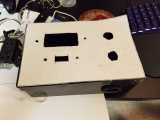When I decided to start working on test equipment, especially vacuum tube gear, one of the first pieces of safety equipment that I purchased was an isolation transformer. It’s something I had heard about many times, in almost every one of Mr. Carlson’s videos and from most of the other channels I watch as well. I made a fused extension cord with a power switch to go along with it, which provides some rudimentary current limiting and a power indicator but still delivers full mains voltage or nothing. In the interest of keeping the magic smoke inside old equipment with suspect capacitors, I wanted to add a dim bulb tester to my bench and put the whole lot on a variac.



High voltages are present within mains powered equipment and often extend out to the chassis. DO NOT attempt to operate or repair mains powered equipment unless you know what you are doing, have proper safety equipment, and someone else is present. Capacitors can retain a lethal charge for a very long time and need to be safely discharged. Do not try this at home.
Danger: High voltage can be fatal!
I do not consider the dim bulb tester to be a piece of personal safety equipment, it is meant to protect old components from catastrophic heat damage. It should always be used with appropriate safety equipment, such as an isolation transformer and rubber gloves. In my opinion, safety equipment should be purchased from a reputable company that can provide test data and insurance certifications. Building your own safety equipment can be dangerous.
The most basic, but still completely functional, dim bulb tester is a junction box and lamp socket, optionally mounted to a piece of plywood. I wanted something a little bit more portable than the plywood, something I can keep on the back of the shelf when it’s not in use and put on my soldering cart or desk when it is. I had a pack of fused C14 sockets for various repair projects, and recently found the Zulkit brand junction/project boxes, which are thick ABS and seemed perfect for this project. These boxes have threaded metal inserts in the corners, at least for the larger sizes, and come with a piece of waterproofing foam bead for the edge. After a little bit of searching, I found some E12 lamp sockets and 15-60W mini bulbs for them, for a maximum capacity of 120 watts.
A quick CAD sketch later, I had a layout that would fit a toggle switch, two bulbs, and a GFCI outlet on the lid of the project box. It took a few attempts to get everything aligned, I’m not entirely sure if I messed up some of the dimensions or if the diagram on Leviton’s website did not match the faceplate exactly, but eventually I got the sketch printed out as a paper template. Some clear tape around the edges held it securely enough to drill out the screw holes and center of each socket. I put a few holes into the switch and outlet areas, then used the Dremel with a cutting wheel and grinding bit to clean them up. The lamp sockets suffered from my freehand cutting, but everything is close enough and the defects are covered up by the faceplate and nuts. The power input went on the side, which makes the fuse accessible without opening the box. To avoid blowing the fuse too often, I plan to add a PPTC between the switch and bulbs, but they have not arrived yet. Bourns has a wide variety of trip/hold current ratings in their MF-RM series, all rated for 240V.
The whole circuit went together easily. Very little soldering was needed since the outlet and switch both have screw terminals. The input socket does require soldering, but the lamps came with stripped leads and could be connected with screw nuts instead. I put heat shrink over the solder joints and loosely screwed the fixtures into the faceplate, lined everything up, and put the lid on the box. My only regret is using piano black, there were fingerprints on the surface before I was even done building the thing.
Parts
For the box and fixtures:
- B&P Lamp E12 Candelabra Socket
- Leviton 80707-E 2-Gang 1-Toggle 1-Decora/GFCI Device Combination Wallplate, Black
- Leviton CS320-2E 20-Amp, 120/277-Volt, Toggle 3-Way AC Quiet Switch
- Leviton GFNT1-E Self-Test SmartlockPro Slim GFCI Non-Tamper-Resistant Receptacle with LED Indicator
- Zulkit Project Box IP65 ABS, 230 x 150 x 85 mm
For the bulbs, you have a few options:
- 20 watt wax warmer, clear orange, 6 pack
- 40 watt Sylvania A15, clear warm white, 2 pack
- 40 watt GE A15, soft white, 2 pack
- 60 watt GE A15, soft white, 2 pack
The 20 watt bulbs can only power small radios and meters. If you plan to work on larger devices, you’ll want to have the 40 and 60 watt bulbs on hand as well, or use full-size sockets. Swapping out the bulbs allows you to tune the current limit for the device under test. Some other values are available as well, such as 15 and 25 watt.





